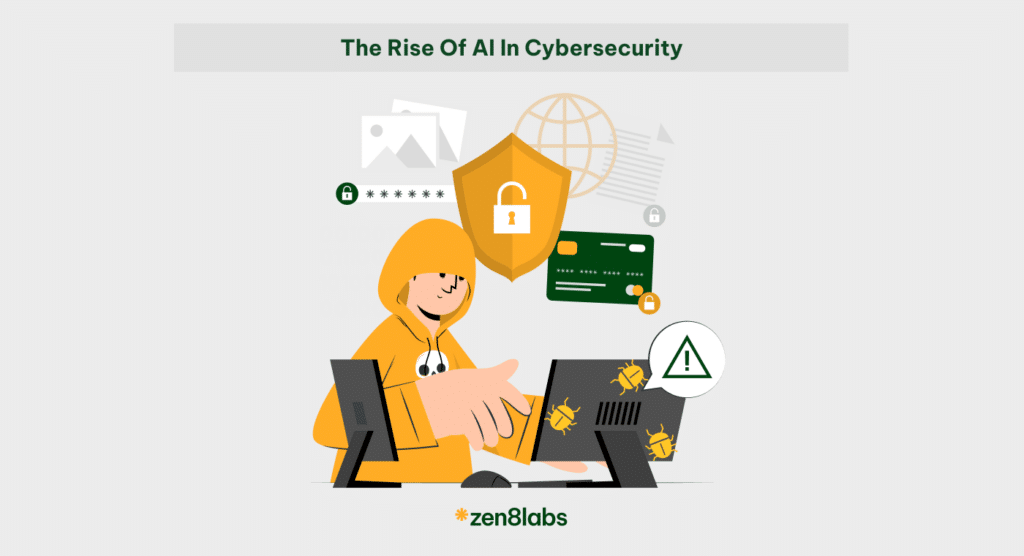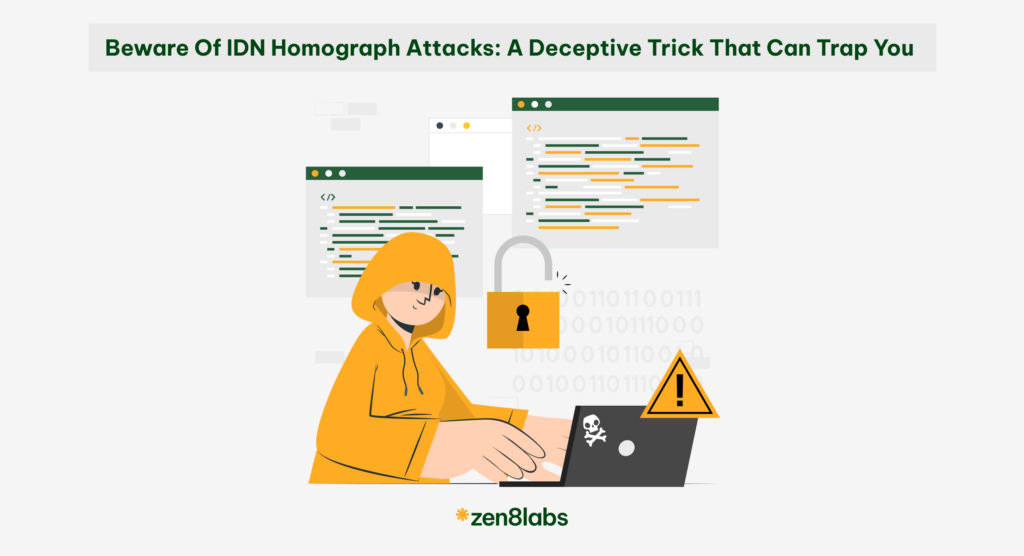
The integration of AI in cybersecurity isn’t new. However, it’s constantly advancing alongside the constantly changing threat landscape. Traditional security solutions often struggle to keep pace with the relentless innovation of cybercriminals. Here is where AI steps in, offering a paradigm shift in how we approach cybersecurity.
What is AI in cybersecurity?
AI in cybersecurity can accelerate threat detection, expediting responses, and protecting user identity and datasets, according to IBM. This data analysis isn’t just about identifying threats; it’s about extracting actionable insights that security professionals can use to investigate, respond to, and report on incidents. Imagine having a tireless security analyst working around the clock, sifting through mountains of data and identifying potential threats. That’s the power of AI.
How does AI in cybersecurity work?
Imagine a security analyst who can analyze terabytes of data – network traffic logs, user logins, application activity and identifying subtle anomalies that might signal a sophisticated cyberattack. That’s the power of AI in cybersecurity. But how exactly does it achieve this superhuman feat?
AI in cybersecurity leverages a subfield of Artificial Intelligence called Machine Learning (ML). ML algorithms are trained on massive datasets of historical security events and network activity. These datasets include:
- Indicators of Compromise (IOCs): Signatures and patterns associated with known malware and cyberattacks.
- Threat Intelligence Feeds: Real-time information about emerging threats and vulnerabilities.
- Network Traffic Logs: Records of all data flowing across your network.
- User Login Data: Information about user login attempts, including timestamps and locations.
By analyzing these vast amounts of data, the ML algorithms learn to recognize patterns that deviate from “normal” network behavior. This “normal” baseline is established through historical data and includes factors like:
- Typical login times for specific users
- Expected traffic volume patterns
- Authorized devices and cloud applications used by employees
- AI’s Continuous Learning Advantage
Here is the beauty of AI: it’s constantly learning and improving. As the ML algorithms process more data over time, they become adept at identifying even the subtlest anomalies that might indicate a cyberattack.
However, AI isn’t here to replace security analysts; it’s here to empower them.
In the next section, we’ll delve deeper into the exciting use cases of AI in cybersecurity, exploring the immense opportunities and potential challenges this technology presents.
The rise of AI in cybersecurity
AI’s roots in cybersecurity trace back to the late 1990s, aiding Intrusion Detection Systems (IDS) in analyzing network traffic anomalies. The 2000s witnessed the rise of machine learning, where algorithms learned from data patterns to identify threats. Behavioral analysis, a form of AI, became a star player, detecting malware by understanding “normal” and flagging deviations.
Fast forward to today: with over 70,000 AI companies vying for a slice of the tech pie. But it’s the purposeful application that matters, not just widespread use. Just like cloud computing, organizations that master AI integration will gain a significant edge.
Cybersecurity faces a relentless barrage of sophisticated attacks, with global cybercrime reaching a staggering $8 trillion in 2023. AI steps in as a much-needed defense mechanism.
The numbers speak for themselves:
- 90% of organizations leverage AI for cybersecurity in some form (IBM).
- 59% of cybersecurity leaders report understaffed teams (ISACA).
- Less than half of organizations are confident in their team’s ability to detect threats (ISACA).
AI empowers security analysts by automating threat detection and analysis, freeing them for strategic tasks.
Is AI important for cybersecurity?
Shining a light in the cloud
Traditional security solutions often struggle with the sprawl of data in a hybrid cloud environment. This is where AI in cybersecurity shines. AI-powered solutions can identify “shadow data” – sensitive information residing outside designated repositories within the cloud. By analyzing access patterns and flagging anomalous activity, AI empowers security teams to detect and prevent potential breaches in real time.
Prioritizing threats, not headaches
Security professionals are inundated with alerts, making it difficult to distinguish critical threats from false positives. AI-powered risk analysis tackles this challenge head-on. It analyzes vast amounts of data and generates clear summaries of high-priority threats. This frees up security professionals to focus on strategic initiatives and crafting targeted responses.
Personalization and protection
AI can personalize the user experience while enhancing security. By analyzing login attempts and user behavior, AI in cybersecurity models can ensure seamless access for verified users. This reduces friction and frustration for legitimate users. Furthermore, research by Forrester indicates that AI-powered security solutions can potentially reduce fraudulent activities by a significant 90%.
Turning data deluge into actionable insights
Security teams are bombarded with data from Security Information and Event Management (SIEM) or Extended Detection and Response (XDR) systems. Manually sifting through this data for real threats is a monumental task. Here, AI in cybersecurity excels. AI can identify critical incidents within the data deluge and correlate seemingly innocuous activities into a clear picture of potential threats. This allows security teams to prioritize their response and swiftly address emerging issues.
Streamlining communication
Generating comprehensive security reports can be a time-consuming task. Generative AI tools can streamline this process. They can pull data from various sources and translate it into clear, concise reports that can be easily shared across the organization. This empowers stakeholders at all levels to understand the threat landscape and make informed decisions.
Plugging the holes before attackers do
AI doesn’t just react to threats, it proactively hunts for vulnerabilities. It can identify issues like unknown devices connecting to the network, outdated software posing security risks, or exposing sensitive data. By pinpointing these vulnerabilities before they can be exploited, AI empowers security teams to take preventative measures and bolster their overall security posture.
Democratizing threat analysis
Generative AI can translate complex cyber threat data into natural language. This empowers security analysts of all experience levels to contribute effectively. They can gain a deeper understanding of threats, learn remediation steps, and respond swiftly to attacks. This not only improves overall team efficiency but also fosters a culture of continuous learning within the security team.
Cutting through the web of deception
Sophisticated cybercriminals often employ various techniques to evade detection. They may create a web of identities, devices, and applications to mask their malicious activities. AI in cybersecurity can counter these deceptive tactics. By analyzing vast amounts of data from multiple sources, AI can pinpoint suspicious behavior and prioritize the most critical threats. This allows security teams to focus their efforts on high-risk actors and take decisive action.
Artificial Intelligence threats: Is AI going to replace cybersecurity?
While Generative AI (particularly Large Language Models, LLMs) are impressive content creators, their Achilles’ heel lies in the data they’re trained on. Here’s where vulnerabilities emerge:
- Hallucinations of fact: AI can fabricate information, presenting falsehoods as truth. This is known as “AI hallucination” and can lead to misguided decision-making.
- Bias and blind spots: AI can inherit biases from its training data, making it susceptible to manipulation through leading questions.
- Toxic tendencies: AI can be coaxed into generating harmful content through “prompt injection attacks.” Attackers exploit these vulnerabilities to manipulate AI output.
- Data poisoning: By tampering with training data (a tactic called “data poisoning”), attackers can corrupt AI models to produce malicious outcomes or exacerbate bias.
- Prompt injection attacks: These occur when attackers craft specific prompts to trick LLMs into unintended behavior. This could involve generating offensive content, revealing sensitive information, or even disrupting systems that rely on LLM input.
AI security solution: 6 use cases of AI in cybersecurity
Rather than replace security professionals, AI in cybersecurity is most effective when it’s used to help them do their jobs more effectively. Some common use cases for AI in cybersecurity security are:
Identity & access on Autopilot
AI empowers Identity and Access Management (IAM) by analyzing user login patterns. It flags anomalies for investigation, automatically enforces two-factor authentication when risky behavior is detected, and even blocks suspicious login attempts – all to safeguard your digital identity.
The AI watchdog
Keeping track of every endpoint within your organization can be a nightmare. AI steps in, identifying all devices and ensuring they’re updated with the latest security patches. AI also plays a crucial role in uncovering malware and other malicious activities targeting your devices.
The AI detective
Extended Detection and Response (XDR) and Security Information and Event Management (SIEM) solutions are essential for threat detection, and AI is their secret weapon. XDR solutions leverage AI to monitor endpoints, emails, user activity, and cloud apps for suspicious behavior. AI can trigger automated responses based on predefined rules, or surface incidents for further investigation by security teams. SIEM, powered by AI, aggregates data from across your organization, giving you a clear picture of potential threats.
Protecting sensitive information
AI is a data guardian, helping security teams identify and classify sensitive data across your network, both on-premises and in the cloud. It can also detect unauthorized data exfiltration attempts, automatically blocking suspicious activity or alerting security professionals for further action.
AI-powered incident response
Sifting through mountains of data during incident response can be a time-consuming ordeal. AI comes to the rescue by identifying and correlating the most critical events from various data sources, saving security professionals valuable time. Generative AI takes it a step further, translating complex analysis into natural language and answering questions in plain English, streamlining the investigation process.
By harnessing the power of AI across these use cases and more, organizations can build a robust cybersecurity posture, staying ahead of evolving threats and protecting their valuable assets.
AI in cybersecurity trends 2024
The role of AI in cybersecurity will only continue to grow. Over the coming years, security professionals can anticipate that:
AI takes over tedious tasks
As AI matures, it will automate a growing range of security tasks, freeing up security operations teams for more strategic initiatives. Repetitive tasks like incident response and mitigation will become increasingly automated, allowing human expertise to be directed toward complex threats.
Proactive defense
Organizations will leverage AI in cybersecurity to proactively identify and address vulnerabilities in their systems, improving their overall security posture. AI can analyze vast amounts of data to pinpoint weaknesses before attackers exploit them.
Developing roles, not replacement
Don’t fear the robot takeover! Security professionals will remain highly sought-after. However, their roles will evolve. They’ll focus on strategic tasks like managing complex security incidents and proactively hunting for emerging threats. AI will become a powerful tool, augmenting human expertise, not replacing it.
AI in the hands of attackers
We can’t ignore the dark side. Cybercriminals are also turning to AI. They may use it to:
- Crack passwords en masse: AI could significantly accelerate password cracking, making strong passwords even more crucial.
- Phishing with precision: AI-powered phishing campaigns could become hyper-realistic, blurring the lines between legitimate emails and malicious attempts.
- Stealthy malware: AI could be used to develop malware that evades traditional detection methods, requiring advanced AI-powered security solutions to stay ahead.
Staying ahead of the curve
AI is a game-changer in cybersecurity, and zen8labs is here to help you win. Our powerful AI solutions empower your security analysts to Spot threats faster, Respond to attacks immediately, Safeguard user identities and data.
All while keeping your security team informed and in control.
Ready to learn more? Schedule a call with a zen8labs representative to discuss how AI-powered solutions can address your organization’s specific cybersecurity needs. Let’s build a stronger defense together!





